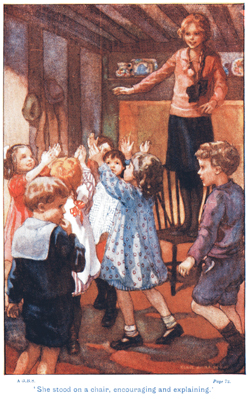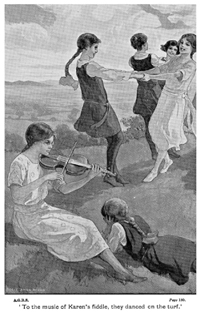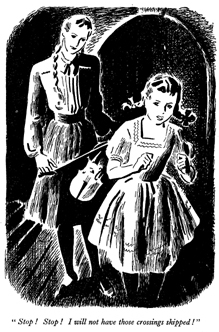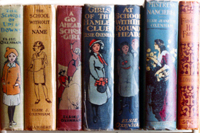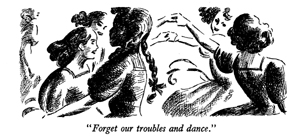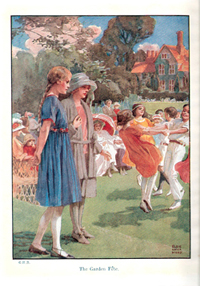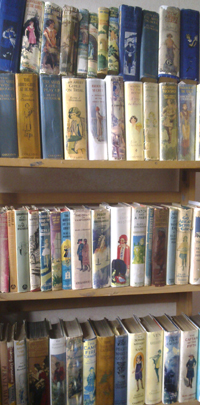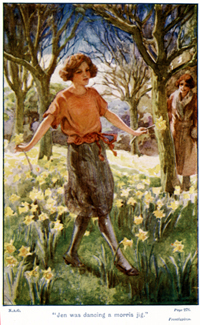|
Folk dancing was central to the plot of the first of Oxenham’s ‘Abbey’ books: The Girls of the Hamlet Club (1914). New (secretly rich) girl Cecily founds the Hamlet Club to give the poorer girls in her school something to do, as the rich girls had made sure that their clubs and societies were too expensive for the country girls to join. What the Hamlet Club does is folk dance, and this eventually brings the whole school together (with the result that all club membership fees are abolished). The Hamlet Club is featured for the rest of the books, the girls remaining members after they grew up, and each year the school-age members elected a May Queen (the choice of whom was often the subject of a sub-plot).
For the next four books the Society’s classes, parties and holiday schools continued to feature within Oxenham’s plots, as did key figures from the Society. Rather than using their real names, Oxenham gave them nicknames: Cecil Sharp became The Prophet; Maud Karpeles his Little Page (the name of a character in the traditional Christmas folk play); and Helen Karpeles and her husband Douglas Kennedy were Mr and Mrs Joshua. Oxenham herself appears as a character in the books featuring the English Folk Dance Society too, as ‘the Writing Person’. In The Abbey Girls Again she explains: “The dancing’s beautiful, and the music’s wonderful, and the people who teach and dance to us are thrillingly interesting personalities, some of them.”
Oxenham’s favourite ‘personality’ of all was Daisy Caroline Daking, immortalized in the books as ‘the Pixie’, and to whom Oxenham partly dedicated two books. Daking was “tiny, but very very neat… She’s a lovely dancer, too. Fair hair—glasses—bright quick blue eyes.” As a result of her interest in Daking, Oxenham began to write about Daking’s work in Canning Town and Plaistow as well, and so brought the area to the attention of generations of readers.
However, folk dancing continued to be important to Oxenham’s characters until the end of the series. The Society made a brief re-appearance in An Abbey Champion (1946), when second-generation character Joan — ‘Littlejan’ — found that the Hamlet Club was now regarded as being solely for the younger pupils at her school. The older girls explained that they were bored of the dances that they knew, and so the Society was asked to recommend a teacher who could introduce them to new dances. It is clear from this episode that Oxenham kept in touch with developments in the folk dance world — characters refer to the “new books” which would have included dances collected by Maud Karpeles after Cecil Sharp’s death.
All images above are copyright and should not be reproduced without permission. Read folk dancing extracts from the Abbey books Text © Ju Gosling aka ju90 2010
|

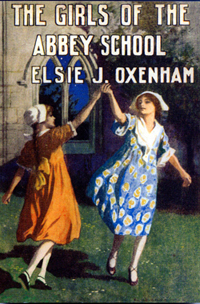

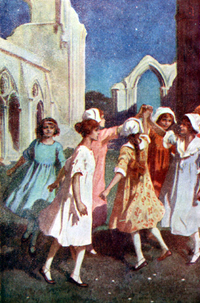
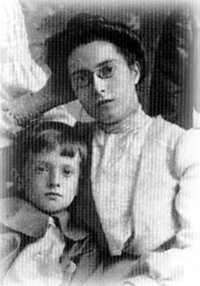 Some
of the best records that we have today of how it felt to be part of
the early folk dance movement are found in the girls’ stories
of Elsie J. Oxenham (1880-1960). Her 38 books about the ‘Abbey
girls’ describe the enjoyment that girls and women — and
some men — found in the songs and dances, and the values that
they embraced along with these. It is clear from her writing that Oxenham
was as much of an enthusiast as her characters were, and passed on this
love of folk to her readers.
Some
of the best records that we have today of how it felt to be part of
the early folk dance movement are found in the girls’ stories
of Elsie J. Oxenham (1880-1960). Her 38 books about the ‘Abbey
girls’ describe the enjoyment that girls and women — and
some men — found in the songs and dances, and the values that
they embraced along with these. It is clear from her writing that Oxenham
was as much of an enthusiast as her characters were, and passed on this
love of folk to her readers.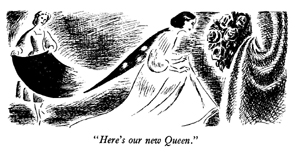
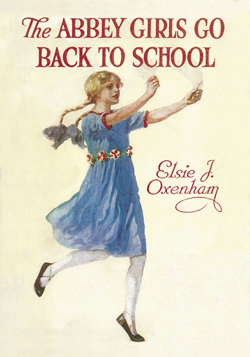 It
was only in 1922, though, with the publication of The Abbey Girls
Go Back to School, that the Abbey girls — now women —
discovered the English Folk Dance Society (EFDS). Initially Cecily had
learned folk dancing at her first school, and had then taught the girls
at her new school “from books” (possibly Cecil Sharp’s).
Now they realize how much they had got wrong. This almost certainly
mirrored Elsie Oxenham’s own experience — Oxenham dedicated
the third book in the Abbey series, The Girls of the Abbey School,
to members of the EFDS for their “helpful enjoyment” and
“kindness”. The Abbey girls therefore spend August in Cheltenham
at the Society’s summer school, learning the correct way to dance
their old favourites as well as being taught new dances.
It
was only in 1922, though, with the publication of The Abbey Girls
Go Back to School, that the Abbey girls — now women —
discovered the English Folk Dance Society (EFDS). Initially Cecily had
learned folk dancing at her first school, and had then taught the girls
at her new school “from books” (possibly Cecil Sharp’s).
Now they realize how much they had got wrong. This almost certainly
mirrored Elsie Oxenham’s own experience — Oxenham dedicated
the third book in the Abbey series, The Girls of the Abbey School,
to members of the EFDS for their “helpful enjoyment” and
“kindness”. The Abbey girls therefore spend August in Cheltenham
at the Society’s summer school, learning the correct way to dance
their old favourites as well as being taught new dances.